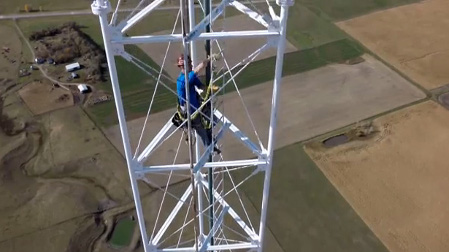Drone Flight Still Challenged by FAA
JOHNSTON, IOWA—I have been doing some research recently on unmanned aerial vehicles (drones) both for the Iowa Public Television production department and for use in engineering to do tower inspections. There is no doubt about it, drones can provide some amazing footage for a production. I happen to think they could also provide some value to IPTV in doing inspections of our towers.
Obviously it wouldn’t replace having a skilled and certified crew climbing the tower and making a true physical inspection but a stable drone with a high definition or even a UHD camera could provide a recording that could be used to look for obvious problems such as bent cross members and damaged antenna elements. It might even provide the tower crew with a look at what they will need to fix prior to climbing the tower.
Please note that I did specify that the drone needed to be a stable platform, especially if the recorded images are going to include surface details for evaluating the condition of an antenna or tower. This will entail a drone with enough mass to minimize being buffeted around by the wind and a skillful operator that can maneuver the UAV in close enough proximity to the tower to make the footage useful.

An image from Prairie Aerial's video of technician changing beacon bulbs on tower.
My inspiration for this idea was this video by Prairie Aerial from a year ago of a technician changing the beacon bulbs on a 1500 foot tower. If you watch the video you can see how stable and detailed the image is. My colleague Deborah McAdams interviewed Prairie Aerial’s principal and photographer Todd Thorin about this video earlier this year. The unit he used was modified to operate at the higher altitude and included a real time downlink from the camera that allows for live ground observation and adjustments.
I cannot over emphasize the importance of operator skills. At this year’s IBC, there was a new featured area called the Drone Zone that allowed attendees to observe and take a hand at flying a drone. I stopped by on a number of occasions to watch and was dismayed to see the number of crashes and damaged done to drones by operators not being familiar or comfortable with their operation. It is obviously not as easy as it looks.
But before you rush out and buy a drone and start using it to spice up productions or take a close look at your transmitting antenna, you need to consider what the Federal Aviation Administration has to say about UAVs and their operation. The first thing to consider is that while anyone can purchase and operate a drone for hobby or recreational purposes, as soon as you start using the drone for production, news gathering, or in the case I have described, tower inspections, it is no longer being operated in accordance with the rules for model aircraft operations. The FAA would classify these as commercial operations and their position on this is that all commercial operations are illegal unless specifically authorized. So while it may be tempting to take your drone out and get some great B-roll for a story or a program, don’t be surprised if you get a call from the FAA telling you to cease and desist. That is essentially what happened to Mr. Thorin when folks at the FAA got to see his video via YouTube.
Now all is not lost as the FAA is developing rules for commercial operations of drones. Until those rules are implemented they do have a procedure for gaining an exemption to the rules that apply to unmanned aircraft. You would need to file a petition for exemption under section 333 of the FAA Modernization and Reform Act of 2012. Instructions for what information needs to be included in the petition and the process can be found on the FAA’s website.
While the procedure is not particularly onerous, be aware that a granted exemption has limitations. For example, the UAV must weigh less than 55 pounds. This probably isn’t much of a concern but it is something to be aware of. Also, daylight only operations tied to local sunrise and sunset, so if you are planning to capture images of the city lights at nights, that would not be advisable.
The UAV’s maximum altitude is 500 feet. This was one of the primary reasons that Mr. Thorin was told to cease operations because his drone was over 1500 feet in the air for some of the shots. I have yet to have a conversation with the FAA about this limitation and any potential for higher operational ceilings for my tower inspection scenarios.
One limitation is the requirement for visual line-of-sight operation. The FAA’s proposes that the UAV must remain with the VLOS of the operator or visual observer. That got me thinking that if we had people over a wide area that were all in direct contact with the operator, we could greatly increase the operational area. Unfortunately, they also specify that the UAV also has to remain close enough for the operator to be able to see the drone without any special devices.
The final limitation that I will mention is that the UAV may not operate over any persons not directly involved in the operation. So again, if you are planning on a dramatic overhead crowd shot at an event, you are probably going to be in violation of the exemption.
Another thing to keep in mind is that in addition to the FAA, about half the states have passed legislation or resolutions to study and/or restrict UAV operations. Most of these have to do more with privacy but they are also focused on property damage and liability.
As I said at the beginning, this is a research project that I have just started on. At this point in time the rules are fluid and it is unclear what the final parameters and restrictions will be. As I get answers to my questions, I will update my readers and maybe I will be able to post a recording of a tower inspection done by a drone in compliance with the FAA.
Get the TV Tech Newsletter
The professional video industry's #1 source for news, trends and product and tech information. Sign up below.
Bill Hayes is the former director of engineering and technology for Iowa PBS and has been at the forefront of broadcast TV technology for more than 40 years. He’s a former president of IEEE’s Broadcast Technology Society, is a Partnership Board Member of the International Broadcasting Convention (IBC) and has contributed extensively to SMPTE and ATSC. He is a recipient of Future's 2021 Tech Leadership Award and SMPTE Fellow.

